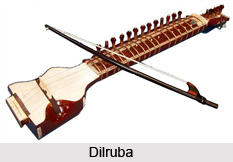 The Dilruba, also called Dilrupa, stands as a bowed musical instrument with its origins rooted in India. Distinguished by its slightly larger dimensions compared to the Esraj, it features a square resonance box. The significance of the Dilruba extends notably within Sikh history, marking its importance in cultural and musical heritage.
The Dilruba, also called Dilrupa, stands as a bowed musical instrument with its origins rooted in India. Distinguished by its slightly larger dimensions compared to the Esraj, it features a square resonance box. The significance of the Dilruba extends notably within Sikh history, marking its importance in cultural and musical heritage.
Etymology of Dilruba
The term "Dilruba," has been denoted to this musical instrument because of its linguistic definition. The word finds its linguistic origins in the Persianized Hindustani word “Dilrubaâ€, which when translated, directly conveys the notion of "any being or object that ravishes the heart."
History of Dilruba
The history of Dilruba as a musical instrument, traces back approximately 300 years ago to the purported invention attributed to the 10th Sikh Guru, Guru Gobind Singh. According to tradition, Guru Gobind Singh fashioned the Dilruba based on the older and bulkier taus, implementing modifications to enhance its portability for the Sikh army, known as the khalsa, facilitating its transportation on horseback.
However, scholarly discourse within the research community casts doubt upon the veracity of this traditional origin account. Some proponents, such as Bhai Avtar Singh Raagi, assert an alternative history, linking the creation of the Dilruba to the patronage of Maharaja Bhupinder Singh and its craftsmanship credited to Mahant Gajja Singh.
Dilruba and Veena
The Dilruba is a cross between the sitar and sarangi. It is extremely close to the esraj and the mayuri vina. This is one of the most well-liked stringed instruments of the bowed variety in Northern India. Dilruba is close to the esraj and the mayuri veena. The difference is in the shape of the resonators and the manner in which the strings are attached. A dilruba player has no trouble in playing an esraj or a mayuri vina and vice versa. It is a young instrument by Indian terms, being only about 200 years old.
Structure of the Dilruba
The neck of Dilruba has around 18 strings. The approach to tuning is similar to the sitar. Almost all of the playing is performed upon only one string. There are a number of metallic frets. Some of these can be moved according to the requirements of the rag. It has a series of sympathetic strings. It is believed that the Dilruba was designed especially for women to play as both the sarangi and the sitar require substantial calluses which can end up disfiguring their fingers. It became popular with Sikh warriors as a light weight portable instrument. It was used in playing shabads, or the hymns of Gurbani kirtan, accompanied by the tabla.
Techniques of Playing Dilruba
The technique of playing the dilruba, a musical instrument, involves several key elements. Primarily, the Dilruba features four primary metal strings. Its soundboard consists of stretched goatskin, akin to the construction of a sarangi. In some instances, a gourd may be attached to the instrument`s top either for balance or to enhance tonal quality.
During performance, the Dilruba can be positioned in various ways for playing convenience. It may be rested between or on the knees while the player kneels, or alternatively placed on the floor directly in front of the musician, with the instrument`s neck resting on the left shoulder.
Playing the Dilruba requires the use of a bow held in the right hand, while the left hand moves longitudinally along the strings above the frets. This movement enables the player to produce desired notes, employing techniques such as sliding notes up or down to achieve the characteristic portamento or meend, prevalent in Indian music.
Popularity of Dilruba
Interest in playing the Dilruba waned during the early 1900`s and the instrument became very scarce until only a few relics remained by the 1980`s. Subsequent to the introduction of the harmonium to the Indian Subcontinent during the era of British colonial rule, the Dilruba experienced a decline in usage due to its perceived higher level of complexity in learning. Nevertheless, in recent years, there has been a resurgence of interest in the dilruba, notably witnessed through its accompaniment of ragis at the Harmandir Sahib or the Golden Temple since 2006. Furthermore, its instructional dissemination has expanded, with increased teaching initiatives both within India and internationally.
Renewed interest in performing kirtan with traditional string instruments revived the art of making the Dilruba. It is an instrument which was designed and created by the Tenth Guru, Gobind Singh Ji.
A. R. Rahman is a well-known composer in India who has used the Dilruba. This instrument is very successful as a complement to vocal music, as an instrument for solo performance or as a composing tool. Simple melodies and the subtlest shades can be produced with ease.




















